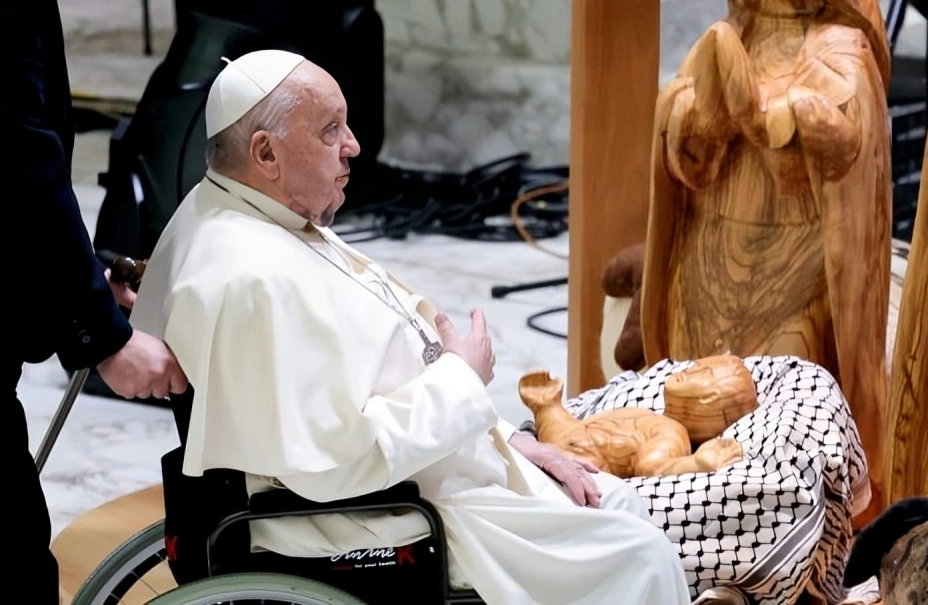
Bethlehem, Palestine— A growing number of churches across the globe have adopted a controversial approach to their nativity scenes this Christmas, depicting baby Jesus wearing a keffiyeh, the traditional Middle Eastern headscarf. Supporters argue the adaptation is meant to raise awareness of Palestinian suffering, while critics see it as a politicization of religious symbols and the Christmas story.
The move has drawn mixed reactions from faith leaders, congregations, and political commentators, highlighting tensions surrounding the Israeli-Palestinian conflict and the role of religious institutions in social justice.
The Controversial Nativity
1. Origin of the Idea
- Advocacy Groups: The keffiyeh nativity concept is believed to have originated with advocacy groups aiming to highlight the plight of Palestinians living under occupation.
- Symbolism: Supporters argue that the keffiyeh is a symbol of resistance and solidarity, fitting for the story of Jesus, who was born into a marginalized community under Roman rule.
2. Church Participation
- Churches in the U.S., Europe, and the Middle East have adopted this portrayal, sparking a wave of discourse.
- Displays often include other elements such as barbed wire or military checkpoints to symbolize contemporary struggles in the Holy Land.
Reactions to the Keffiyeh Nativity
1. Supporters See it as Advocacy
- Faith Leaders: Some clergy argue that the nativity scenes reflect the modern-day struggles of oppressed communities, aligning with Christian values of empathy and justice.
- Reverend Mark Thomas, U.K.: “The message of Christ is one of compassion for the marginalized. This depiction reminds us of our call to action.”
- Pro-Palestinian Advocates: Praise the displays for drawing attention to the plight of Palestinians during the season of peace and goodwill.
2. Critics Call it Politicization
- Traditionalists: Oppose the adaptation, arguing it undermines the universality of Jesus by tying him to a specific modern political cause.
- Bishop Francis O’Reilly, U.S.: “The nativity should unite, not divide. Adding contemporary political imagery risks alienating believers.”
- Jewish Communities: Some groups have expressed concern, viewing the keffiyeh as a politically charged symbol that could exacerbate tensions.
3. Divided Congregations
- Churchgoers have reported mixed feelings, with some applauding the message of solidarity and others expressing discomfort over perceived politicization of sacred traditions.
Public Opinion: What’s True and Untrue?
- True:
- The keffiyeh has been adopted in some nativity scenes to highlight Palestinian suffering.
- Advocates link the portrayal to Jesus’s historical context of being born under occupation.
- Untrue:
- Claims that the adaptation has received universal approval among churches are false; the response has been polarizing.
- Assertions that the keffiyeh is solely a political symbol ignore its cultural and historical significance in the Middle East.
The Broader Implications
1. Intersection of Religion and Politics
The keffiyeh nativity raises questions about the role of religious institutions in addressing contemporary political issues.
2. Focus on the Holy Land
- Tourism and Advocacy: The controversy has renewed attention on Bethlehem and the broader Israeli-Palestinian conflict, sparking calls for peace initiatives.
3. Global Christian Identity
This adaptation reflects broader debates within Christianity about how the faith addresses social justice and modern-day oppression.
What’s Next?
1. Dialogues Within the Church
Faith leaders will need to navigate discussions on the appropriateness of politicized religious imagery, balancing tradition with contemporary advocacy.
2. Public Awareness
The keffiyeh nativity scenes will likely prompt broader discussions about the role of Christians in advocating for marginalized groups globally.
3. Potential Backlash
As the controversy grows, some churches may face pushback from their congregations or external groups, leading to further polarization.
Conclusion: A Thought-Provoking Debate
The depiction of baby Jesus in a keffiyeh has ignited passionate debates about the intersection of religion, politics, and social justice. While some see it as a powerful message of solidarity, others fear it risks dividing the faithful.
As Veritas World News observes, “The keffiyeh nativity challenges Christians to reflect on how faith engages with the realities of the modern world without losing its universal message of hope and unity.”
#KeffiyehNativity #Christianity #PalestinianAdvocacy #SocialJustice #VeritasWorldNews
